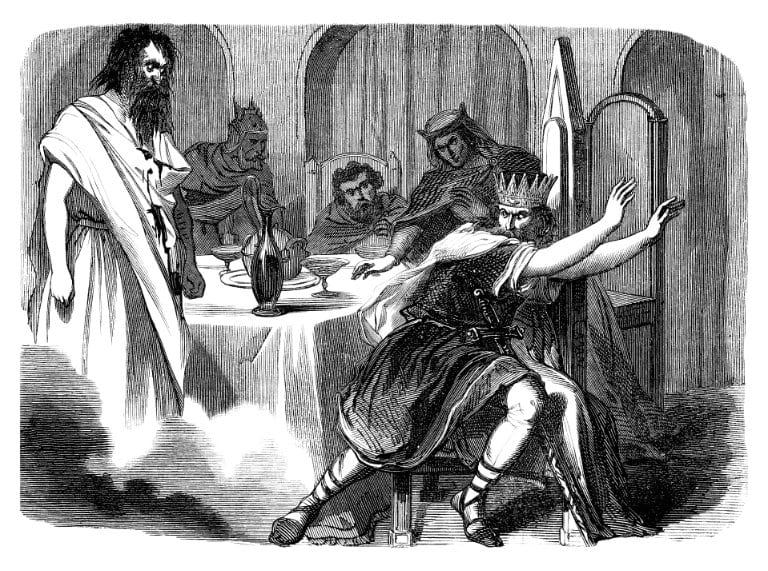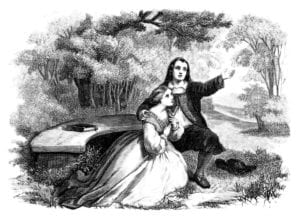The appearance of a ghost in the opening scenes of “Hamlet” suggests that this is a play with Catholic sympathies at a time when this was a dangerous affiliation. Ghosts were a feature of the world of superstition and witchcraft that Protestant Europe wanted to leave behind, making the appearance of the ghost of Hamlet’s father a provocative gesture. So is “Hamlet” genuinely a Catholic text? It emerges later that Hamlet himself studies at no less a university than Wittenberg, the home of Martin Luther and therefore (in a sense) of Protestantism, so any conclusions must be provisional. More likely, perhaps, Shakespeare merely thought of ghosts as dramatic assets – indeed, a ghost appears in no fewer than five of his plays.
In “Hamlet” the ghost of the late King appears initially not to Hamlet but to the castle guards. Their reaction is to denounce what they see as a “fantasy” and an “illusion”. But they have faith enough to address it and then watch how it reacts: “it was about to speak” they notice, “when the cock crew”. Hamlet’s first reaction is sceptical: “Be thou a spirit of health or goblin damn’d?” he asks, but he follows it against Horatio’s advice and is quickly persuaded of its authenticity. From this point in the play, Hamlet’s life is dedicated to acting on the ghost’s account of the late King’s murder. So whatever Protestant doctrine Hamlet has absorbed in Wittenberg now seems surplus to his requirements.
The ghost’s reappears during Hamlet’s fractious interview with his mother Gertrude in Act 3 Scene 4. This time, for whatever reason, the ghost has had a change of clothes, and appears not in martial attire but “in his nightgown”. His mission is clear enough: “This visitation”, he explains to Hamlet, “Is but to whet thy almost blunted purpose” – a reaction, perhaps, to the fact that Hamlet has just passed up the chance to kill Claudius. The most striking feature of this scene is perhaps the fact that whereas in the opening act the ghost is visible to the guards among others, here only Hamlet can see him. This explains the Queen’s perplexity – “You do bend your eye on vacancy”, she tells him, adding that she can see “Nothing at all; yet all that is, I see”.
Lady Macbeth experiences similar confusion, and reacts in much the same way, when the ghost of Banquo appears at the feast in Act 3 Scene 4, in the immediate aftermath of his murder. At first Macbeth addresses the ghost directly, pleading somewhat disingenuously “Thou canst not say I did it”. Twenty lines later, when he confronts the ghost a second time (“If thou canst nod, speak too”), it disappears. It’s here that Lady Macbeth’s reaction evokes memories of Gertrude: “When all’s done”, she tells her husband, “You look but on a stool”. Later, when the ghost reappears, Macbeth once again addresses it directly: “Hence horrible shadow! / Unreal mockery, hence!” The ghost obliges, and disappears a second time.
Two conclusions may be drawn. First, Shakespeare’s ghosts are visible to some but not all characters: Hamlet sees his father, and so do Horatio and the guards – indeed they are sworn to secrecy at what they have witnessed – but Gertrude doesn’t. Similarly, Macbeth sees Banquo’s ghost, but Lady Macbeth is bewildered by what she witnesses, and the various Lords and others are also excluded. It’s tempting to describe the ghost of Banquo as an hallucination, but Shakespeare’s stage direction is quite clear: “The GHOST OF BANQUO enters, and sits in MACBETH’S place”. The second conclusion is that Shakespeare’s ghosts can speak, though they don’t have to, and their speech may be as fluent and informed as if they were still alive. In Act 3 Scene 1, Hamlet describes death as “The undiscover’d country, from whose bourn / No traveller returns”, but his father’s ghost and Banquo’s suggest that this isn’t a complete picture.
Banquo’s ghost is the only spectre in Shakespeare who doesn’t speak, though not all are as eloquent as Hamlet senior. When Caesar’s ghost appears to Brutus in Act 4 Scene 3 of “Julius Caesar”, Brutus is as perplexed as Hamlet was: “Art thou some god, some angel or some devil?” he exclaims – to which Caesar’s ghost laconically replies “Thy evil spirit, Brutus”. There follows the briefest of dialogues: “Why comest thou?” asks Brutus, to which Caesar replies “To tell thee thou shalt see me at [the battle of] Philippi”, and once that has been confirmed (“Ay, at Philippi”), the ghost disappears. But Brutus is haunted, and after the battle he reveals that the ghost has now appeared to him twice (“at Sardis once / And this last night”), and “I know my hour has come”. As he stabs himself to death, Caesar’s ghost is uppermost in his mind as he calls on his ghost to “be still”.
Rather more forthcoming (if not more eloquent) are the three ghosts that appear in the penultimate scene of “Cymbeline”. While Posthumus sleeps, abandoned in a prison cell and awaiting execution, the ghosts of his father, mother and brother appear on the stage pleading with Jupiter to pardon him. True, the stage directions describe them as “apparitions”, but they describe themselves as “ghosts”, and Jupiter follows suit: “How dare you ghosts / Accuse the thunderer”, he reproves them, and he counsels them to “Be content”. As it happens he is as good as his word, and releases Posthumus to reconcile with Imogen in the play’s closing scene. It is fair to add that the lines assigned to the three ghosts (described in one guide to the play as “doggerel”) are not necessarily by Shakespeare.
“Cymbeline” (c 1609) is a late play, but ghosts have a long history in Shakespeare’s stagecraft. The first appearance of a ghost in Shakespeare is almost certainly in “Richard III” (c 1592). Here, on the eve of battle, Richard is visited (as Brutus is) by the ghosts of his victims: first, Prince Edward, then his father Henry VI, followed by his brother Clarence, then the Lords Rivers, Gray and Vaughan, followed by his old associate Hastings, then the ghosts of the two young princes, the ghost of his late wife Lady Anne, and finally that of another former companion Buckingham. Each of the ten clears his mind of his feelings towards Richard (“die in terror of thy guiltiness”, says Buckingham), though in fairness Richard still fights bravely on the following day. Nonetheless, like Brutus he is defeated.
Ghosts play a range of different roles in these plays. In “Cymbeline” they appear as apparitions, figures perhaps of Posthumus’s dream, whereas in “Richard III” they seem to be a cry of conscience, an expression of the guilt he’s suppressed in a long career of spilling the blood of his rivals. Banquo’s ghost plays a similar role in Macbeth’s tortured psychology, a phenomenon (like the dagger) “Proceeding from the heat-oppressed brain”, and perhaps the same can be said for Brutus. In each case, the central character is confronted by his own victim as an involuntary statement of his interior life. The ghost in Hamlet’s father, witnessed by more than one observer, is a third variety, given that the prince seems to have had no idea about his father’s fate. This particular ghost is believed by long theatrical tradition to have been played by Shakespeare himself – a reminder of the dramatic impact the ghost has, whatever its religious implications.





One Response
I always took the fact that Hamlet is the only play in which other people see the same ghost as a clue to what was happening. Norway has bribed the ‘ghost’ and the guards with the idea of ensuing chaos. The idea is to destabilize Denmark and prepare for the eventual takeover. I would surmise that it was they who assassinated the King. This would also help explain Gertrude and Claudius’ hasty marriage.